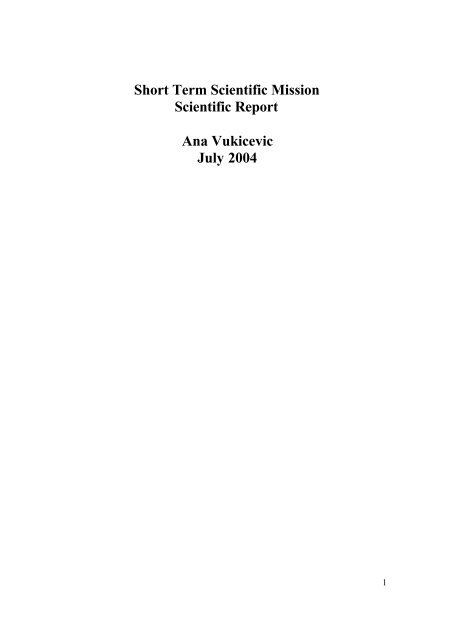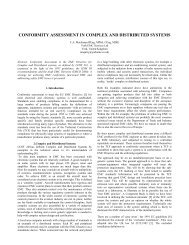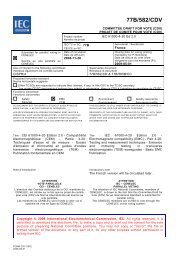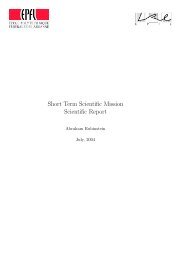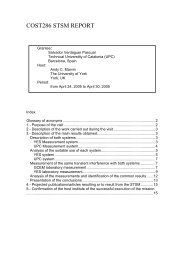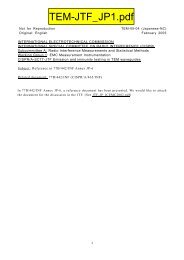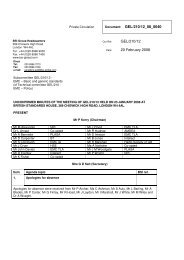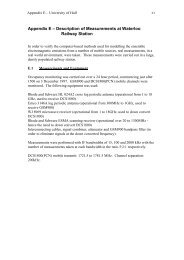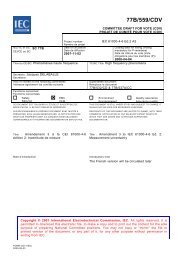Ana Vukicevic, Host - Applied Electromagnetics Group
Ana Vukicevic, Host - Applied Electromagnetics Group
Ana Vukicevic, Host - Applied Electromagnetics Group
- No tags were found...
Create successful ePaper yourself
Turn your PDF publications into a flip-book with our unique Google optimized e-Paper software.
Short Term Scientific MissionScientific Report<strong>Ana</strong> <strong>Vukicevic</strong>July 20041
1. IntroductionThis is the report of the visit to the Ängström Laboratory in Uppsala, Sweden, carried out inthe frame of a Short Term Scientific Mission. This introduction is the first of a total of fivesections that make up this report. Section 2 presents the purpose of the visit. Section 3describes the work carried out. Main results, conclusions and perspectives are presented insection 4.2. Purpose of the visitThe main purpose of the Scientific Mission was (1) to initiate a collaboration in the fieldof Power Line Communication Systems between the EMC group of the Swiss FederalInstitute of Technology, Lausanne and the EMC group of the Uppsala University, (2)Discuss common research activities dealing with transient analysis along multiconductorlines and line radiation, and (3) compare measurement results of transfer impedance ofshielded cables carried out using two different set-ups in Lausanne and in Uppsala.3. Work carried outPower Line Communication (PLC) SystemsNew power line communication (PLC) approaches using radio frequency range 1-30MHz have been developed in the last few years allowing data transmission rates of theorder of a few Mbit/s. One major concern related to these systems is the electromagneticfield radiation.The EMC team of the Uppsala University is starting to work in the field of emissionsfrom PLC networks. The team has extensive experience in measurements and calculationof emissions and coupling of electromagnetic fields to different types of cabling.The EMC <strong>Group</strong> of the Swiss Federal Institute of Technology is active in the field onPLC since 1999. The <strong>Group</strong> is an active partner of the European IP Project OPERA(Open Plc European Research Alliance). Since PLC technology has not been properlydeveloped to this moment, the main objective of the project is to perform the necessaryresearch, demonstration and dissemination at a European scale in order to overcome theobstacles for the PLC technology. The scientific and technological objectives of theproject are (1) improvement of current PLC systems, low voltage (LV) as well asmedium voltage (MV) by means of bandwidth, distances reached, ease of operation,EMC, network management, channel modeling. (2) Development of optimal solutions forconnection of the PLC access networks to backbone networks. (3) Standardisation ofPLC system. EPFL group is mainly active in the domain of electromagnetic compatibilityand standardisation.<strong>Ana</strong> <strong>Vukicevic</strong> from Lausanne and Ph.D. students N. Theethayi and Y. Liu from Uppsalapresented their respective activities and discussions were conducted with the aim ofestablishing a possible cooperation in the area of PLC.2
Transients along transmission lines and inclusion of antenna-mode currentsFor a multiconductor line, and even for electrically small line cross section, the presenceof antenna-mode currents makes that the sum of the currents at a cross section is notnecessarily equal to zero. If we desire to compute only the load responses of the line,considering only the TL model current is adequate, because the antenna mode currentresponse is small near the ends of the line. On the other hand, if we wish to evaluate thecurrent along the line, the presence of antenna-mode currents needs to be taken intoaccount, even for electrically small line cross sections. In particular, in order to computethe field radiated by power line communication signals along indoor low-voltage powerlines, it is compulsory to take into account the contribution of the antenna-mode currentswhich are predominant.As part of her Ph.D. thesis in Lausanne, <strong>Ana</strong> <strong>Vukicevic</strong> has derived a specific integralequation describing the antenna-mode currents along a two-wire transmission line. Whenthe line cross-sectional dimensions are electrically small, the integral equation reduces toa pair of transmission line-like equations with equivalent line parameters (inductance andcapacitance). The derived equations make it possible to compute the antenna modecurrents using a traditional transmission line code with appropriate parameters.In Figure 1, we present the comparison between the results for the antenna-mode currentsobtained using the proposed method and those obtained numerically using NEC.Fig. 1 Comparison between NEC and approximation results3
The work carried out by Nelson Theethayi as part of his Ph.D. thesis in Uppsala dealswith crosstalk phenomena on transmission lines. Mr. Theethayi’s work could be appliedto PLC networks for cases in which cabling from adjacent premises run sufficiently closeto one another.During the visit, the two approaches were discussed and compared.- Measurement methods for the transfer impedance of communication cablesPrior to the Short Term Mission of Ms. <strong>Vukicevic</strong>, measurements of transfer impedanceof different communication cables have been performed by the two groups. In Lausanne,the transfer impedance is determined in frequency domain using a triaxial set-up. TheEPFL experiment setup is shown in Fig. 3.Fig. 2 Measurement of transfer impedanceFig. 3 Experimental set-up used at EPFLIn Uppsala, the measurements are performed using a time-domain approach (fast impulsesource). The Uppsala experiment setup is shown in Fig. 4.4
Fig. 4 Experimental set-up used in UppsalaIn Figure 5, we present the experimental data obtained on a test cable using the triaxialset-up.Cable Ericsson TEL 301 6005/0041.00E+041.00E+03Module [mΩ/m]1.00E+021.00E+011.00E+001.00E+03 1.00E+04 1.00E+05 1.00E+06 1.00E+07 1.00E+08Frequency [Hz]5
Cable Ericsson TEL 301 6005/004200150100Phase [ °]500-50-100-150-2001.00E+03 1.00E+04 1.00E+05 1.00E+06 1.00E+07 1.00E+08Frequency [Hz]Fig. 5 – Measurement of the transfer impedance of a test cable using the triaxial set-up.4. Conclusions and perspectivesThe short term mission permitted to initiate a cooperation between the EMC <strong>Group</strong> of theSwiss Federal Institute of Technology, Lausanne and the Uppsala University. Preliminarycommon works between the two groups have been carried out during the STSM.It is planned to continue the collaborative efforts in the field of PLC and transientanalysis initiated during the STSM in the future.6


